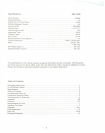
-----------.
.
ALWAYS USE SAFETY GLASSES. Also use face or dust masks if the cutting operation is dusty-
Everyday eyeglasses only have impact resistant lenses, they are NOT safety glasses.
'-'-"
.
SECURE WORK. Useclamps or a vise to hold the work when its practical. It's safer than using your
hand and it frees both hands to operatethe tool.
.
DON'T OVERREACH. Keep properfootingand balanceat all times.
.
MAINTAIN TOOLS WITH CARE. Keeptools sharp and cleanfor best and safest performance. Follow
instructions for lubricatingand changingaccessories.
.
DISCONNECT TOOLS before servicing; when changing accessories, such as blades, bits cutters, and
the like.
.
REDUCETHE RISKOF UNINTENTIONALSTARTING. Make sure the switch is in the off position
before plugging in the machine.
.
USE RECOMMENDEDACCESSORIES. Consult the owner's manual for recommendedaccessories.
The use of improperaccessoriesmaycause a risk of injury.
.
NEVER STAND ON A TOOL. Serious injury could occur if the tool is tipped or if the cutting tool is
unintentionally contacted.
-
.
CHECK DAMAGED PARTS. Beforefurther useof the tool, a guard or other part that is damaged
should be carefully checked to determinethat it will operateproperlyand perform its intended function.
Check for alignmentof movingparts, bindingof moving parts, breakage of parts, mounting, and any
other conditionsthat may affect its operation. A guard or other part that is damaged should be properly
repaired or replaced.
.
DIRECTION OF FEED. Feedwork into a blade or cutter againstthe direction of rotation of the blade or
cutter only.
.
NEVER LEAVETHE TOOL RUNNINGUNATTENDED. TURNTHE POWER OFF. Don't leave the
tool until it comes to a complete stop.
- -- - - ~
- - - - - - -- ~ - - - ,.
'-


















